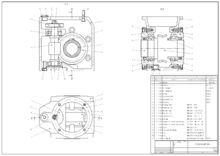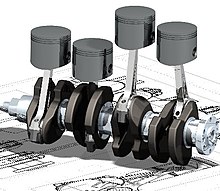Computer-aided design (CAD), also known as computer-aided design and drafting (CADD) [1] , is the use of computer technology for the process of design and design-documentation. Computer Aided Drafting describes the process of drafting with a computer. CADD software, or environments, provides the user with input-tools for the purpose of streamlining design processes; drafting, documentation, and manufacturing processes. CADD output is often in the form of electronic files for print or machining operations. The development of CADD-based software is in direct correlation with the processes it seeks to economize; industry-based software (construction, manufacturing, etc.) typically uses vector-based (linear) environments whereas graphic-based software utilizes raster-based (pixelated) environments.
CADD environments often involve more than just shapes. As in the manual drafting of technical and engineering drawings, the output of CAD must convey information, such as materials, processes, dimensions, and tolerances, according to application-specific conventions.
CAD may be used to design curves and figures in two-dimensional (2D) space; or curves, surfaces, and solids in three-dimensional (3D) objects.[2]
CAD is an important now days because of estimation studying various activity as real time industrial art extensively used in many applications, including automotive, shipbuilding, and aerospace industries, industrial and architectural design, prosthetics, and many more. CAD is also widely used to produce computer animation for special effects in movies, advertising and technical manuals. The modern ubiquity and power of computers means that even perfume bottles and shampoo dispensers are designed using techniques unheard of by engineers of the 1960s. Because of its enormous economic importance, CAD has been a major driving force for research in computational geometry, computer graphics (both hardware and software), and discrete differential geometry.[3]
The design of geometric models for object shapes, in particular, is occasionally called computer-aided geometric design (CAGD).[4]
Contents |
Overview
Beginning in the 1980s Computer-Aided Design programs reduced the need of draftsmen significantly, especially in small to mid-sized companies. Their affordability and ability to run on personal computers also allowed engineers to do their own drafting work, eliminating the need for entire departments. In today’s world most, if not all, students in universities do not learn drafting techniques because they are not required to do so. The days of hand drawing for final drawings are all but over. Universities no longer require the use of protractors and compasses to create drawings, instead there are several classes that focus on the use of CAD software such as Pro Engineer or IEAS-MS.
Current computer-aided design software packages range from 2D vector-based drafting systems to 3D solid and surface modellers. Modern CAD packages can also frequently allow rotations in three dimensions, allowing viewing of a designed object from any desired angle, even from the inside looking out. Some CAD software is capable of dynamic mathematic modeling, in which case it may be marketed as CADD — computer-aided design and drafting.
CAD is used in the design of tools and machinery and in the drafting and design of all types of buildings, from small residential types (houses) to the largest commercial and industrial structures (hospitals and factories).
[5] CAD is mainly used for detailed engineering of 3D models and/or 2D drawings of physical components, but it is also used throughout the engineering process from conceptual design and layout of products, through strength and dynamic analysis of assemblies to definition of manufacturing methods of components. It can also be used to design objects.
CAD has become an especially important technology within the scope of computer-aided technologies, with benefits such as lower product development costs and a greatly shortened design cycle. CAD enables designers to lay out and develop work on screen, print it out and save it for future editing, saving time on their drawings.
Uses
Computer-aided design is one of the many tools used by engineers and designers and is used in many ways depending on the profession of the user and the type of software in question.
CAD is one part of the whole Digital Product Development (DPD) activity within the Product Lifecycle Management (PLM) process, and as such is used together with other tools, which are either integrated modules or stand-alone products, such as:
- Computer-aided engineering (CAE) and Finite element analysis (FEA)
- Computer-aided manufacturing (CAM) including instructions to Computer Numerical Control (CNC) machines
- Photo realistic rendering
- Document management and revision control using Product Data Management (PDM).
CAD is also used for the accurate creation of photo simulations that are often required in the preparation of Environmental Impact Reports, in which computer-aided designs of intended buildings are superimposed into photographs of existing environments to represent what that locale will be like were the proposed facilities allowed to be built. Potential blockage of view corridors and shadow studies are also frequently analyzed through the use of CAD..
CAD has also has been proven to be useful to engineers as well. Using four properties which are history, features, parameterization, and high level constraints (Zhang). The construction history can be used to look back into the model’s personal features and work on the single area rather than the whole model (zhang). Parameters and constraints can be used to determine the size, shape, and the different modeling elements. The features in the CAD system can be used for the variety of tools for measurement such as tensile strength, yeild strength, also its stress and strain and how the element gets affected in certain temperatures.
Types
There are several different types of CAD [6] . Each of these different types of CAD systems require the operator to think differently about how he or she will use them and he or she must design their virtual components in a different manner for each.
There are many producers of the lower-end 2D systems, including a number of free and open source programs. These provide an approach to the drawing process without all the fuss over scale and placement on the drawing sheet that accompanied hand drafting, since these can be adjusted as required during the creation of the final draft.
3D wireframe is basically an extension of 2D drafting (not often used today). Each line has to be manually inserted into the drawing. The final product has no mass properties associated with it and cannot have features directly added to it, such as holes. The operator approaches these in a similar fashion to the 2D systems, although many 3D systems allow using the wireframe model to make the final engineering drawing views.
3D “dumb” solids are created in a way analogous to manipulations of real world objects (not often used today). Basic three-dimensional geometric forms (prisms, cylinders, spheres, and so on) have solid volumes added or subtracted from them, as if assembling or cutting real-world objects. Two-dimensional projected views can easily be generated from the models. Basic 3D solids don’t usually include tools to easily allow motion of components, set limits to their motion, or identify interference between components.
3D parametric solid modeling require the operator to use what is referred to as “design intent”. The objects and features created are adjustable. Any future modifications will be simple, difficult, or nearly impossible, depending on how the original part was created. One must think of this as being a “perfect world” representation of the component. If a feature was intended to be located from the center of the part, the operator needs to locate it from the center of the model, not, perhaps, from a more convenient edge or an arbitrary point, as he could when using “dumb” solids. Parametric solids require the operator to consider the consequences of his actions carefully.
Some software packages provide the ability to edit parametric and non-parametric geometry without the need to understand or undo the design intent history of the geometry by use of direct modeling functionality. This ability may also include the additional ability to infer the correct relationships between selected geometry (e.g., tangency, concentricity) which makes the editing process less time and labor intensive while still freeing the engineer from the burden of understanding the model’s. These kind of non history based systems are called Explicit Modellers or Direct CAD Modelers.
Top end systems offer the capabilities to incorporate more organic, aesthetics and ergonomic features into designs. Freeform surface modelling is often combined with solids to allow the designer to create products that fit the human form and visual requirements as well as they interface with the machine.
Technology
A CAD model of a computer mouse.
Originally software for Computer-Aided Design systems was developed with computer languages such as Fortran, but with the advancement of object-oriented programming methods this has radically changed. Typical modern parametric feature based modeler and freeform surface systems are built around a number of key C modules with their own APIs. A CAD system can be seen as built up from the interaction of a graphical user interface (GUI) with NURBS geometry and/or boundary representation (B-rep) data via a geometric modeling kernel. A geometry constraint engine may also be employed to manage the associative relationships between geometry, such as wireframe geometry in a sketch or components in an assembly.
Unexpected capabilities of these associative relationships have led to a new form of prototyping called digital prototyping. In contrast to physical prototypes, which entail manufacturing time in the design. That said, CAD models can be generated by a computer after the physical prototype has been scanned using an industrial CT scanning machine. Depending on the nature of the business, digital or physical prototypes can be initially chosen according to specific needs.
Today, CAD systems exist for all the major platforms (Windows, Linux, UNIX and Mac OS X); some packages even support multiple platforms.
Right now, no special hardware is required for most CAD software. However, some CAD systems can do graphically and computationally intensive tasks, so a modern graphics card, high speed (and possibly multiple) CPUs and large amounts of RAM may be recommended.
The human-machine interface is generally via a computer mouse but can also be via a pen and digitizing graphics tablet. Manipulation of the view of the model on the screen is also sometimes done with the use of a Spacemouse/SpaceBall. Some systems also support stereoscopic glasses for viewing the 3D model.
History
[7] [8] [9] [10] Designers have long used computers for their calculations. Initial developments were carried out in the 1960s within the aircraft and automotive industries in the area of 3D surface construction and NC programming, most of it independent of one another and often not publicly published until much later. Some of the mathematical description work on curves was developed in the early 1940s by Robert Issac Newton from Pawtucket, Rhode Island. Robert A. Heinlein in his 1957 novel The Door into Summer suggested the possibility of a robotic Drafting Dan. However, probably the most important work on polynomial curves and sculptured surface was done by Pierre Bezier (Renault), Paul de Casteljau (Citroen), Steven Anson Coons (MIT, Ford), James Ferguson (Boeing), Carl de Boor (GM), Birkhoff (GM) and Garibedian (GM) in the 1960s and W. Gordon (GM) and R. Riesenfeld in the 1970s.
It is argued that a turning point was the development of the SKETCHPAD system at MIT in 1963 by Ivan Sutherland (who later created a graphics technology company with Dr. David Evans). The distinctive feature of SKETCHPAD was that it allowed the designer to interact with his computer graphically: the design can be fed into the computer by drawing on a CRT monitor with a light pen. Effectively, it was a prototype of graphical user interface, an indispensable feature of modern CAD.
The first commercial applications of CAD were in large companies in the automotive and aerospace industries, as well as in electronics. Only large corporations could afford the computers capable of performing the calculations. Notable company projects were at GM (Dr. Patrick J.Hanratty) with DAC-1 (Design Augmented by Computer) 1964; Lockheed projects; Bell GRAPHIC 1 and at Renault (Bezier) – UNISURF 1971 car body design and tooling.
One of the most influential events in the development of CAD was the founding of MCS (Manufacturing and Consulting Services Inc.) in 1971 by Dr. P. J. Hanratty,[11] who wrote the system ADAM (Automated Drafting And Machining) but more importantly supplied code to companies such as McDonnell Douglas (Unigraphics), Computervision (CADDS), Calma, Gerber, Autotrol and Control Data.
As computers became more affordable, the application areas have gradually expanded. The development of CAD software for personal desktop computers was the impetus for almost universal application in all areas of construction.
Other key points in the 1960s and 1970s would be the foundation of CAD systems United Computing, Intergraph, IBM, Intergraph IGDS in 1974 (which led to Bentley Systems MicroStation in 1984)
CAD implementations have evolved dramatically since then. Initially, with 3D in the 1970s, it was typically limited to producing drawings similar to hand-drafted drawings. Advances in programming and computer hardware, notably solid modeling in the 1980s, have allowed more versatile applications of computers in design activities.
Key products for 1981 were the solid modelling packages –Romulus (ShapeData) and Uni-Solid (Unigraphics) based on PADL-2 and the release of the surface modeler CATIA (Dassault Systemes). Autodesk was founded 1982 by John Walker, which led to the 2D system AutoCAD. The next milestone was the release of Pro/ENGINEER in 1988, which heralded greater usage of feature-based modeling methods and parametric linking of the parameters of features. Also of importance to the development of CAD was the development of the B-rep solid modeling kernels (engines for manipulating geometrically and topologically consistent 3D objects) Parasolid (ShapeData) and ACIS (Spatial Technology Inc.) at the end of the 1980s and beginning of the 1990s, both inspired by the work of Ian Braid. This led to the release of mid-range packages such as SolidWorks in 1995, Solid Edge (then Intergraph) in 1996 and Autodesk Inventor in 1999.
See also
| Wikiversity has learning materials about Computer-aided design |
| Wikimedia Commons has media related to: Computer-aided design |
| Look up computer-aided design in Wiktionary, the free dictionary. |
- Computer-aided industrial design
- CAD standards
- Comparison of CAD editors for AEC (architecture, engineering and construction)
- Comparison of Free EDA software (Electronic Design Automation)
- 3D computer graphics software
- Additive Manufacturing File Format
- Comparison of 3D computer graphics software
- Digital architecture
- Electronic design automation
- Integrating functionality
- ISO 128
- Model based definition
- Molecular design software
References
- ^ Vijay Duggal. “CADD Primer”. Mailmax Publishing. http://www.caddprimer.com/cadd_primer_chapters/drawing_design_automation_introduction_0.htm.
- ^ Farin, G.: A History of Curves and Surfaces in CAGD, Handbook of Computer Aided Geometric Design
- ^ H. Pottmann, S. Brell-Cokcan, and J. Wallner:Discrete surfaces for architectural design
- ^ Gerald Farin :Curves and Surfaces for CAGD: A Practical Guide
- ^ Jennifer Herron (2010). “3D Model-Based Design: Setting the Definitions Straight”. MCADCafe. http://www10.mcadcafe.com/nbc/articles/2/867959/3D-Model-Based-Design-Setting-Definitions-Straight.
- ^ “engineershandbook – Types of CAD”. http://engineershandbook.com/Software/cad2.htm#3dp.
- ^ “History of CAD/CAM”. CADAZZ. 2004. http://www.cadazz.com/cad-software-history.htm.
- ^ Pillers, Michelle (1998.03). “MCAD Renaissance of the 90’s”. Cadence Magazine. http://www.edeinc.com/Cadence/98Mar/Article98Mar.html.
- ^ Bozdoc, Martian. “The History of CAD”. iMB. http://mbinfo.mbdesign.net/CAD-History.htm.
- ^ Carlson, Wayne (2003). “A Critical History of Computer Graphics and Animation”. Ohio State University. http://accad.osu.edu/~waynec/history/lesson10.html.
- ^ “MCS Founder”. http://www.mcsaz.com/about/founder.htm.
Mengchi, L. (1999). On cad databases. Electrical and Computer Engineering, 1999 IEEE Canadian Conference on , 1, 325-327.
Yingzhong , Z, & LastXiaofang , L. (2009). Design intent information exchange of feature-based cad models. Computer Science and Information Engineering, 3, 11-15



